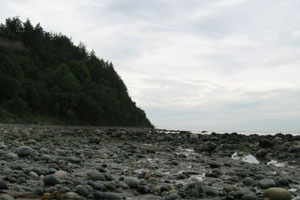Storm Watching

The beach at Point Wilson.
When to go:
December, January, February
Where to go:
What to look for:
January usually brings the highest winds, but any blustery day can bring new treasures to the beach.
Heading out while the winds are still blowing is rarely a good idea. Find a place to cozy up until the storm blows over and then head out to see what you can find. Dress warmly and use common sense - don't put yourself in danger just to get a closer look at something.
Also keep in mind that if you are in a State or National Park, collecting is prohibited! If you find something that you think may be tsunami debris, report it to a ranger.
-
Flotsam & Jetsam
Technically speaking, flotsam refers to floating wreckage. Jetsam is stuff that has been thrown overboard. To most of us, though, flotsam and jetsam just means anything interesting that has washed ashore. That, or the sinister eels from Disney's The Little Mermaid
One of the most prized beach finds around here are glass floats from old fishing nets. They are getting rarer, so if you spot one consider yourself lucky.
-
Tsunami Debris
Debris from the March 11, 2011 tsunami in Japan is already arriving on our coast. Some of the debris could be carrying invasive species that would wreak havoc on the ecosystem of the Salish Sea. If you find something that you think is tsunami debris, report it to a ranger as soon as you can.
-
Seaweed
Usually the only way to see deep-water seaweeds is to go scuba diving, or use a dredge. Winter storms offer another option: walk the wrack-line and see what you can find. The wrack-line is left by the highest waves, and will usually be obvious. There may be multiple lines of debris - the one closest to the water will be the most recent.
Bring a good seaweed identification card or booklet - you'll be amazed at just how many different kinds there are! Some of the most common will be kelp (a favorite for kids), rockweed, sea lettuce and turkish washcloth. You may also find eelgrass.
-
Pelagic Birds
Pelagic means sea-going, and usually these birds are very difficult to see since they hardly ever come to land. Albatrosses are the most well-known pelagic bird, and they are a great example of what these birds look like: generally gull-like, but with very long, narrow wings adapted for soaring across the waves.
Winter storms sometimes blow pelagic birds off-course, bringing them close to shore. Some birds are even killed, and will wash up on the beach. While this may seem a bit gross, finding a dead pelagic bird can be a great opportunity to learn more about them. If you find one, don't touch it with bare hands, and report it to a ranger if you are in a park - they may want to collect it for study.
-
Seals & Sea Lions
Seals and sea lions are year-round residents of the Salish Sea, so you have just as much chance of seeing them in winter as you do in summer. Watch for them coming up to breathe, and hauled out on rocks and buoys. If it's a still day, you may even hear them. Sea lions are quite vocal, and seals make a blowing sound when they surface.
-
Fossils
You have to be very lucky indeed to find a fossil on the beach, but it can happen! Many of the bluffs that line Puget Sound are made of glacial sediment, left behind at the end of the last Ice Age. Sometimes those bluffs contain fossilized tusks and teeth from the Columbian Mammoth (our state fossil!).
A big storm may cause new erosion, exposing fresh sediments. Walk along the bluffs looking for recent mudslides. Don't climb the bluffs, even if you see something that looks promising - the slope is probably unstable and you don't want to make the evening news. And remember that collecting is prohibited on public lands!
Sources:
Washington State Parks, 2012
PTMSC, 2012
Images by Molly Kent
